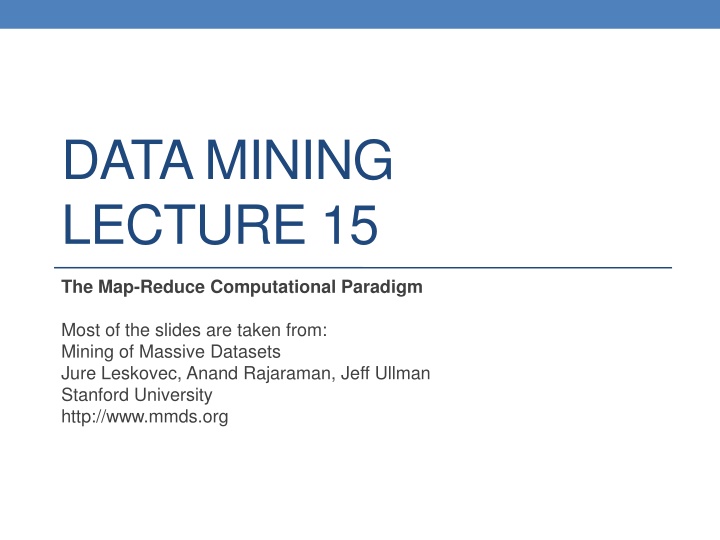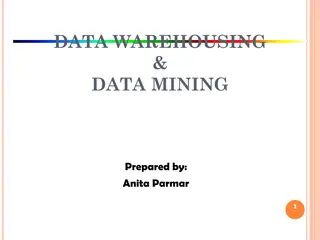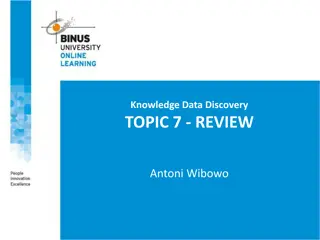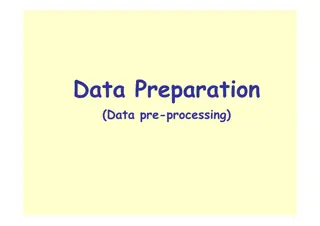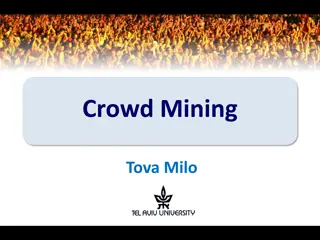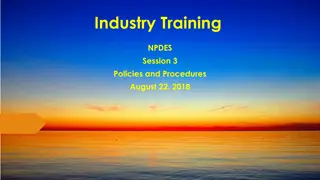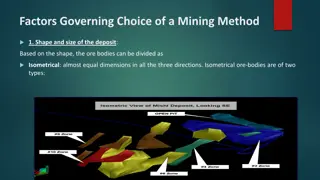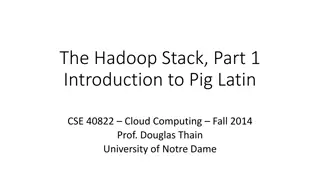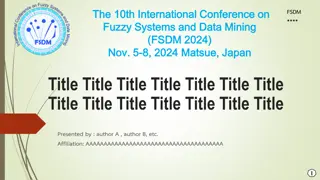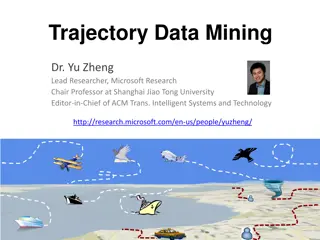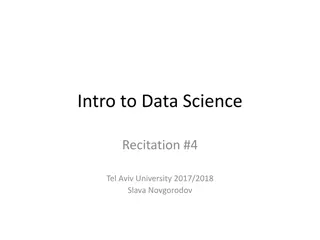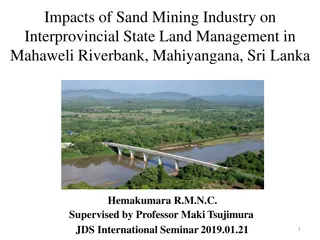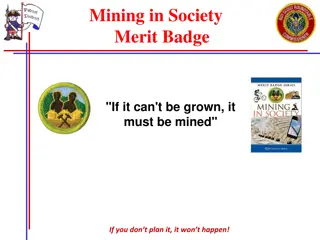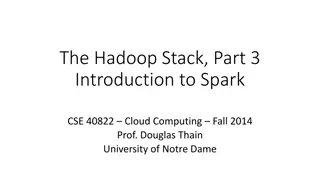Map-Reduce Computational Paradigm in Data Mining
This lecture delves into the Map-Reduce computational paradigm as outlined in "Mining of Massive Datasets" by Jure Leskovec, Anand Rajaraman, and Jeff Ullman from Stanford University. It addresses challenges of dealing with massive amounts of data, including distributed computation and the need for cluster architectures. The presentation highlights the motivation behind Google's approach to handling extensive data volumes and the cluster architecture involved. It explores large-scale computing and the complexities associated with processing vast datasets.
Download Presentation

Please find below an Image/Link to download the presentation.
The content on the website is provided AS IS for your information and personal use only. It may not be sold, licensed, or shared on other websites without obtaining consent from the author.If you encounter any issues during the download, it is possible that the publisher has removed the file from their server.
You are allowed to download the files provided on this website for personal or commercial use, subject to the condition that they are used lawfully. All files are the property of their respective owners.
The content on the website is provided AS IS for your information and personal use only. It may not be sold, licensed, or shared on other websites without obtaining consent from the author.
E N D
Presentation Transcript
DATA MINING LECTURE 15 The Map-Reduce Computational Paradigm Most of the slides are taken from: Mining of Massive Datasets Jure Leskovec, Anand Rajaraman, Jeff Ullman Stanford University http://www.mmds.org
J. Leskovec, A. Rajaraman, J. Ullman: Mining of Massive Datasets, http://www.mmds.org 2 Large Scale data mining Challenges: How to deal with massive amount of data? Storing the web requires Petabytes of data! How to distribute computation? Distributed/parallel programming is hard Map-reduce addresses all of the above Google s computational/data manipulation model Elegant way to work with big data
J. Leskovec, A. Rajaraman, J. Ullman: Mining of Massive Datasets, http://www.mmds.org 3 Single Node Architecture CPU Machine Learning, Statistics Memory Classical Data Mining Disk
J. Leskovec, A. Rajaraman, J. Ullman: Mining of Massive Datasets, http://www.mmds.org 4 Motivation: Google Example 20+ billion web pages x 20KB = 400+ TB 1 computer reads 30-35 MB/sec from disk ~4 months to read the web ~1,000 hard drives to store the web Takes even more to do something useful with the data! Today, a standard architecture for such problems is emerging: Cluster of commodity Linux nodes Commodity network (ethernet) to connect them
J. Leskovec, A. Rajaraman, J. Ullman: Mining of Massive Datasets, http://www.mmds.org 5 Cluster Architecture 2-10 Gbps backbone between racks 1 Gbps between any pair of nodes in a rack Switch Switch Switch CPU CPU CPU CPU Mem Mem Mem Mem Disk Disk Disk Disk Each rack contains 16-64 nodes In 2011 it was guestimated that Google had 1M machines, http://bit.ly/Shh0RO
J. Leskovec, A. Rajaraman, J. Ullman: Mining of Massive Datasets, http://www.mmds.org 6
J. Leskovec, A. Rajaraman, J. Ullman: Mining of Massive Datasets, http://www.mmds.org 7 Large-scale Computing Large-scale computing for data mining problems on commodity hardware Challenges: How do you distribute computation? How can we make it easy to write distributed programs? Machines fail: One server may stay up 3 years (1,000 days) If you have 1,000 servers, expect to loose 1/day People estimated Google had ~1M machines in 2011 1,000 machines fail every day!
J. Leskovec, A. Rajaraman, J. Ullman: Mining of Massive Datasets, http://www.mmds.org 8 Idea and Solution Issue: Copying data over a network takes time Idea: Bring computation close to the data Store files multiple times for reliability Map-reduce addresses these problems Google s computational/data manipulation model Elegant way to work with big data Storage Infrastructure File system Google: GFS. Hadoop: HDFS Programming model Map-Reduce
J. Leskovec, A. Rajaraman, J. Ullman: Mining of Massive Datasets, http://www.mmds.org 9 Storage Infrastructure Problem: If nodes fail, how to store data persistently? Answer: Distributed File System: Provides global file namespace Google GFS; Hadoop HDFS; Typical usage pattern Huge files (100s of GB to TB) Data is rarely updated in place Reads and appends are common
J. Leskovec, A. Rajaraman, J. Ullman: Mining of Massive Datasets, http://www.mmds.org 10 Distributed File System Chunk servers File is split into contiguous chunks Typically each chunk is 16-64MB Each chunk replicated (usually 2x or 3x) Try to keep replicas in different racks Master node a.k.a. Name Node in Hadoop s HDFS Stores metadata about where files are stored Might also be replicated Client library for file access Talks to master to find chunk servers Connects directly to chunk servers to access data
J. Leskovec, A. Rajaraman, J. Ullman: Mining of Massive Datasets, http://www.mmds.org 11 Distributed File System Reliable distributed file system Data kept in chunks spread across machines Each chunk replicated on different machines Seamless recovery from disk or machine failure C1 C2 C0 D0 C1 C5 C0 C5 D1 D0 D0 C2 C5 C2 C3 C5 Chunk server 1 Chunk server 3 Chunk server N Chunk server 2 Bring computation directly to the data! Chunk servers also serve as compute servers
J. Leskovec, A. Rajaraman, J. Ullman: Mining of Massive Datasets, http://www.mmds.org 12 Programming Model: MapReduce Warm-up task: We have a huge text document Count the number of times each distinct word appears in the file Sample application: Analyze web server logs to find popular URLs Find the frequency of words in the Web.
J. Leskovec, A. Rajaraman, J. Ullman: Mining of Massive Datasets, http://www.mmds.org 13 Task: Word Count Case 1: File too large for memory, but all <word, count> pairs fit in memory Case 2: Count occurrences of words: words(doc.txt) | sort | uniq -c where words takes a file and outputs the words in it, one per a line Case 2 captures the essence of MapReduce Great thing is that it is naturally parallelizable
J. Leskovec, A. Rajaraman, J. Ullman: Mining of Massive Datasets, http://www.mmds.org 14 MapReduce: Overview Sequentially read a lot of data Map: Extract something you care about Group by key: Sort and Shuffle Reduce: Aggregate, summarize, filter or transform Write the result Outline stays the same, Map and Reduce change to fit the problem
J. Leskovec, A. Rajaraman, J. Ullman: Mining of Massive Datasets, http://www.mmds.org 16 MapReduce: The Map Step Input Data elements (key-value pairs) Intermediate key-value pairs k v map Important: Different shapes correspond to different types of keys and values! v k k v map v k k v v k v k
J. Leskovec, A. Rajaraman, J. Ullman: Mining of Massive Datasets, http://www.mmds.org 17 MapReduce: The Reduce Step Output key-value pairs Intermediate key-value pairs Key-value groups reduce k v k v v v k v reduce Group by key k v k v k v v k v k v k v k v
J. Leskovec, A. Rajaraman, J. Ullman: Mining of Massive Datasets, http://www.mmds.org 18 More Specifically Input: a set of data elements that we think of as key-value pairs E.g., key is the filename, value is a single line in the file Programmer specifies two methods: Map(?,?) <? ,? >* Takes a key-value pair and outputs a set of new key-value pairs E.g., the key ? is a word and the value ? is 1. One such pair is produced for each appearance of the word in the input line There is one Map call for every (?,?) pair Reduce(? , <? > ) <? ,? >* All values ? with same key ? are reduced together and processed in ? order There is one Reduce function call per unique key ? The output is a new key value pair, where for each key ? a new value ? is computed from the set of values associated with ? E.g., the value ? is the sum of values ?
J. Leskovec, A. Rajaraman, J. Ullman: Mining of Massive Datasets, http://www.mmds.org 19 MapReduce: Word Counting Provided by the programmer Provided by the programmer Group by key: Collect all pairs with same key MAP: Reduce: Collect all values belonging to the key and output Read input and produces a set of key-value pairs Sequentially read the data Only sequential reads The crew of the space shuttle Endeavor recently returned to ambassadors, harbingers of a new era of space exploration. Scientists at NASA are saying that the recent assembly of the Dextre bot is the first step in a long-term space-based man/mache '"The work we're doing now -- the robotics we're doing - - is what we're going to need .. (The, 1) (crew, 1) (of, 1) (the, 1) (space, 1) (shuttle, 1) (Endeavor, 1) (recently, 1) . (crew, 1) (crew, 1) (space, 1) (the, 1) (the, 1) (the, 1) (shuttle, 1) (recently, 1) Earth as (crew, 2) (space, 1) (the, 3) (shuttle, 1) (recently, 1) partnership. Big document (key, value) (key, value) (key, value)
J. Leskovec, A. Rajaraman, J. Ullman: Mining of Massive Datasets, http://www.mmds.org 20 Word Count Using MapReduce map(key, value): // key: document name; value: text of the document for each word w in words(value): emit(w, 1) reduce(key, values): // key: a word; value: an iterator over counts result = 0 for each count v in values: result += v emit(key, result)
J. Leskovec, A. Rajaraman, J. Ullman: Mining of Massive Datasets, http://www.mmds.org 21 Map-Reduce: Environment Map-Reduce environment takes care of: Partitioning the input data Scheduling the program s execution across a set of machines Performing the group by key step Handling machine failures Managing required inter-machine communication
J. Leskovec, A. Rajaraman, J. Ullman: Mining of Massive Datasets, http://www.mmds.org 22 Map-Reduce: A diagram Big document MAP: Read input and produces a set of key-value pairs Group by key: Collect all pairs with same key (Hash merge, Shuffle, Sort, Partition) Reduce: Collect all values belonging to the key and output
J. Leskovec, A. Rajaraman, J. Ullman: Mining of Massive Datasets, http://www.mmds.org 23 Map-Reduce: In Parallel All phases are distributed with many tasks doing the work
J. Leskovec, A. Rajaraman, J. Ullman: Mining of Massive Datasets, http://www.mmds.org 24 Map-Reduce Programmer specifies: Map and Reduce and input files Workflow: Read inputs as a set of key-value-pairs Map transforms input (k,v)-pairs into a new set of (k ,v )-pairs Sorts & Shuffles the (k'v )-pairs to output nodes All (k ,v )-pairs with a given k are sent to the same reduce Reduce processes all (k ,v )-pairs grouped by key into new (k ,v )-pairs Write the resulting pairs to files Input 0 Input 1 Input 2 Map 0 Map 1 Map 2 Shuffle Reduce 0 Reduce 1 Out 1 Out 0 All phases are distributed with many tasks doing the work
J. Leskovec, A. Rajaraman, J. Ullman: Mining of Massive Datasets, http://www.mmds.org 25 Data Flow Input and final output are stored on a distributed file system (FS): Scheduler tries to schedule map tasks close to physical storage location of input data Intermediate results are stored on local FS of Map and Reduce workers Output is often input to another MapReduce task
J. Leskovec, A. Rajaraman, J. Ullman: Mining of Massive Datasets, http://www.mmds.org 26 Coordination: Master Master node takes care of coordination: Task status: (idle, in-progress, completed) Idle tasks get scheduled as workers become available When a map task completes, it sends the master the location and sizes of its R intermediate files, one for each reducer Master pushes this info to reducers Master pings workers periodically to detect failures
J. Leskovec, A. Rajaraman, J. Ullman: Mining of Massive Datasets, http://www.mmds.org 28 Dealing with Failures Map worker failure Map tasks completed or in-progress at worker are reset to idle Reduce workers are notified when task is rescheduled on another worker Reduce worker failure Only in-progress tasks are reset to idle Reduce task is restarted Master failure MapReduce task is aborted and client is notified
J. Leskovec, A. Rajaraman, J. Ullman: Mining of Massive Datasets, http://www.mmds.org 29 How many Map and Reduce jobs? M map tasks, R reduce tasks Rule of a thumb: Make M much larger than the number of nodes in the cluster One DFS chunk per map is common Improves dynamic load balancing and speeds up recovery from worker failures Usually R is smaller than M Because output is spread across R files
J. Leskovec, A. Rajaraman, J. Ullman: Mining of Massive Datasets, http://www.mmds.org 30 Task Granularity & Pipelining Fine granularity tasks: map tasks >> machines Minimizes time for fault recovery Can do pipeline shuffling with map execution Better dynamic load balancing
J. Leskovec, A. Rajaraman, J. Ullman: Mining of Massive Datasets, http://www.mmds.org 31 Refinements: Backup Tasks Problem Slow workers significantly lengthen the job completion time: Other jobs on the machine Bad disks Weird things Solution Near end of phase, spawn backup copies of tasks Whichever one finishes first wins Effect Dramatically shortens job completion time
J. Leskovec, A. Rajaraman, J. Ullman: Mining of Massive Datasets, http://www.mmds.org 32 Refinement: Combiners Often a Map task will produce many pairs of the form (k,v1), (k,v2), for the same key k E.g., popular words in the word count example Can save network time by pre-aggregating values in the mapper: combine(k, list(v1)) v2 Combiner is usually same as the reduce function Works only if Reduce function is commutative and associative
J. Leskovec, A. Rajaraman, J. Ullman: Mining of Massive Datasets, http://www.mmds.org 33 Refinement: Combiners Back to our word counting example: Combiner combines the values of all keys of a single mapper (single machine): Much less data needs to be copied and shuffled!
J. Leskovec, A. Rajaraman, J. Ullman: Mining of Massive Datasets, http://www.mmds.org 34 Refinement: Partition Function Want to control how keys get partitioned Inputs to map tasks are created by contiguous splits of input file Reduce needs to ensure that records with the same intermediate key end up at the same worker System uses a default partition function: hash(key) mod R Sometimes useful to override the hash function: E.g., hash(hostname(URL)) mod R ensures URLs from a host end up in the same output file
PROBLEMS SUITED FOR MAP-REDUCE
J. Leskovec, A. Rajaraman, J. Ullman: Mining of Massive Datasets, http://www.mmds.org 36 Examples Counting tasks Find the total size in bytes of a host Compute the frequency of all k-grams on the web Compute the frequency of queries Compute the frequency of query,url pairs Other examples: Link analysis and graph processing PageRank Machine Learning algorithms Linear algebra operations (matrix-vector, matrix-matrix multiplication)
J. Leskovec, A. Rajaraman, J. Ullman: Mining of Massive Datasets, http://www.mmds.org 37 Example: Join By Map-Reduce Compute the natural join R(A,B) S(B,C) R and S are each stored in files Tuples are pairs (a,b) or (b,c) A a1 a2 a3 a4 B b1 b1 b2 b3 B b2 b2 b3 C c1 c2 c3 A a3 a3 a4 B b2 b2 b3 C c1 c2 c3 = S R
J. Leskovec, A. Rajaraman, J. Ullman: Mining of Massive Datasets, http://www.mmds.org 38 Map-Reduce Join A Map process turns: Each input tuple R(a,b) into key-value pair (b,(a,R)) Each input tuple S(b,c) into (b,(c,S)) Map processes send each key-value pair with key b to Reduce process h(b) (where h is a hash function) Hadoop does this automatically; just tell it what the key is. Each Reduce process matches all the pairs (b,(a,R)) with all (b,(c,S)) from the list of values associated with b, and outputs (a,b,c).
Other database operations All SQL operations can be implemented using map-reduce: Select Project Union Difference Equi-Join Left-outer join
Matrix-Vector multiplication Compute the product of matrix ? with vector ? ???= ????? ? This is an operation that appears very often in many different tasks E.g., the computation of the PageRank vectors. The size of the Web matrix is in the order of billions! But it is a very sparse matrix Storage: The matrix and vectors are stored in a sparse form: Triplets of the form (?,?,???) for the non-zero entries of the matrix Pairs of the form ?,?? for the elements of the vector.
Matrix-vector multiplication Case 1: The vector fits in memory In this case the vector that we want multiply is loaded in memory at each mapper. Recall that we want to compute: ????? ? for entry ? of the output vector. How should we define the map-reduce process? The mapper reads a chunk of the matrix M, and for each entry ?,?,??? it outputs the key-value pair (?,?????) The reducer takes the sum of all values that are associated with row ?.
Matrix-vector multiplication Case 2: The vector does not fit in memory In this case we split the matrix and the vector into stripes: We perform the computation for each stripe of the matrix, where the vector can fit into memory For PageRank it is better to split the matrix into blocks.
Extenstions: Pregel- Giraph Data and computation is modeled as a Graph. Each node in the graph handles a task Each node output messages to the remaining nodes Each node processes the incoming messages from other nodes. Computation is performed in supersteps: In one superstep all messages are processed, and new messages are sent out. Failures The computation is periodically checkpointed after a number of supersteps. Pregel: developed by Google. Giraph: open-source version Although a general computation model, it is usually used for computations on graphs.
Example: All pairs shortest paths Data: the edges of a large graph with weights Compute: the shortest path between any two nodes Each node in Pregel stores information about a node in the input graph and connects with its neighbors For node ? we store the pairs (?,???) with the distance of ? to all other nodes Initially only to immediate neighbors At each step each node ? broadcasts the distances (?,?,???) to its neighbors. When node ? receives message (?,?,???), it checks if there are pairs (?,???) and (?,???) stored locally If ???+ ???< ??? then it updates the pair ?,???.
POINTERS AND FURTHER READING
J. Leskovec, A. Rajaraman, J. Ullman: Mining of Massive Datasets, http://www.mmds.org 46 Implementations Google Not available outside Google Hadoop An open-source implementation in Java Uses HDFS for stable storage Download: http://lucene.apache.org/hadoop/ Aster Data Cluster-optimized SQL Database that also implements MapReduce
J. Leskovec, A. Rajaraman, J. Ullman: Mining of Massive Datasets, http://www.mmds.org 47 Reading Jeffrey Dean and Sanjay Ghemawat: MapReduce: Simplified Data Processing on Large Clusters http://labs.google.com/papers/mapreduce.html Sanjay Ghemawat, Howard Gobioff, and Shun- Tak Leung: The Google File System http://labs.google.com/papers/gfs.html
J. Leskovec, A. Rajaraman, J. Ullman: Mining of Massive Datasets, http://www.mmds.org 48 Resources Hadoop Wiki Introduction http://wiki.apache.org/lucene-hadoop/ Getting Started http://wiki.apache.org/lucene-hadoop/GettingStartedWithHadoop Map/Reduce Overview http://wiki.apache.org/lucene-hadoop/HadoopMapReduce http://wiki.apache.org/lucene-hadoop/HadoopMapRedClasses Eclipse Environment http://wiki.apache.org/lucene-hadoop/EclipseEnvironment Hadoop releases from Apache download mirrors http://www.apache.org/dyn/closer.cgi/lucene/hadoop/ Javadoc http://lucene.apache.org/hadoop/docs/api/
Other systems Apache Spark https://spark.apache.org/ A different distributed computation software stack running over HDFS, or Amazon S3 Developed by UC Berkeley On top of Apache Spark: Spark SQL: allows for querying structured and semi- structured data MLlib Apache Mahout: Distributed Machine Learning framework Implements clustering, classification, dimensionality reduction algorithims GraphX: Distributed Graph processing framework, similar to Pregel Implements several graph processing algorithms
Other systems Apache Hive: https://hive.apache.org/ Distributed Data Warehousing system. Works over HDFS and Amazon S3. HiveQL: SQL like querying language. Developed by Facebook. GraphLab and GraphChi Distributed Graph processing framework Pregel-like computation
